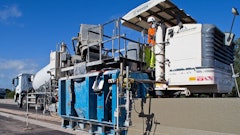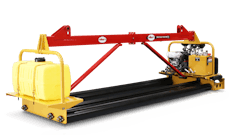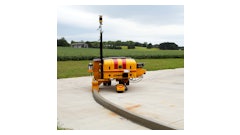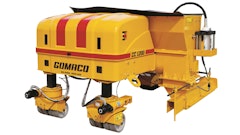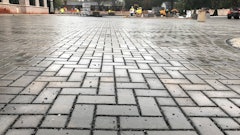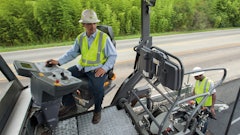
Originally published in Gomaco World.
N. Piccoli Construction Ltd. was created in 1983 by Nick Piccoli in London, Ontario, Canada. In 1984, he bought his company’s first GOMACO Commander III and it has been nothing but Commander IIIs ever since. At 80 years old, Nick still visits jobsites and checks on the crews, but the day-to-day operation of the company is managed by his son, Mario. Piccoli Construction specializes in curb and gutter and sidewalk on road reconstruction projects and subdivisions.
They are meticulous about creating a superior product for their customers and take pride in slipforming the straightest curb and gutter possible. Piccolis are not afraid of tight radius work in their parking lot projects.
They have always pushed the limits of their Commanders and along the way have created some innovative new ways to get things accomplished on their jobsites, from 6-foot radii to a new style of driveway depressor for their molds.
The company’s newest Commander III is like no other Commander III ever built by GOMACO. It features rotary-sensored slew drives on each of the three tracks. The slew drives now allow the Commander III to slipform a 24-inch radius. The curb and gutter machine also features new radius software that allows the operator to program the size of the radius into the G+ controller. As the Commander III approaches that radius, with the values already dialed in, the operator flips a switch activating the tight radius program and the machine slipforms around the radius.
Sensor inputs on the sideshifting mold help ensure proper positioning traveling through the radius. G+ also manages the speed of the three-tracks so each of them is traveling at the necessary speed.
“That’s all incorporated with the slew drives,” Mario Piccoli, owner of Piccoli Construction, said. “When doing a tight radius, our operator is aware of the size of the radius and he adjusts that into the controller. The controller automatically knows what angle to set the tracks at and the machine pours around the radius flawlessly. You can do that on the fly, as well. If there’s multiple radii, if we go from a 20 foot into a 10 foot into a five foot, just a weird shape, he can adjust as he’s going without ever having to stop the machine for any reason. It can do it all on the fly.
“It does a great job. Before, we would have to manipulate the machine to do the tight radii, but now its just flip the switch, away it goes, and we don’t even have to think about it. We’ve done 4-foot, 5-foot radii, no problem.”
The tracks with rotary-sensored slew drives also make slipforming curb and gutter in tough parking lot conditions much easier. The tracks can turn at 90 degree angles to crab steer towards or away from the stringline in tight operating conditions. The feature was put to the test on a small parking lot project in London. The project required only 656 feet of curb, but included several 90 degree corners, a driveway entrance, and only short slipforming runs inside the fenced-in area.
“In a parking lot like this, it helps out quite a bit when you can turn the tracks that tight, spin the machine right on a dime and negotiate the tight corners and tricky scenarios,” Piccoli said.
This Commander III’s tight-turning capabilities led to some software developments and upgrades to better accommodate its abilities. Three upgrades, to be precise, and all of the software modifications have been accomplished telematically using GOMACO Remote Diagnostics (GRD). The G+ and its steering system were modified to better react to the turning abilities of the rotary-sensored slew drives. Icons on the G+ screen were also made larger, just as a matter of operator preference. The software changes were written at GOMACO’s corporate headquarters in Ida Grove, Iowa, USA, and sent to London, Ontario, Canada, using GRD. GOMACO’s Service Department, and Piccoli himself, also have the ability to monitor Piccoli’s machine using GRD.
“We’ve had three upgrades already through telematics and that technology is amazing,” Piccoli said. “We called GOMACO with an idea and 30 minutes later, it’s been updated. It’s also kind of cool talking to DeWayne Krayenhagen (GOMACO’s service/warranty manager) in service and him knowing exactly where my machine is at any given time, knowing all the functions and what the parameters are, what everything is set at, and what it’s running at. If we ever have an issue, I can see that being pretty useful.”
Piccoli Construction knew the rotary-slew drives would help them turn a tight radius, but they’re finding an added bonus. The curb and gutter that they’ve poured with their Commander III with rotary-slew drives is the straightest the company has ever slipformed.
“We’ve always prided ourselves on putting down straight curb, but I’ve never put down straighter curb than this,” Piccoli said. “Never. It’s amazing, and this machine can do a radius like nothing. You’d think that maybe the straight curb would get sacrificed, but it isn’t. I’m almost happy with just the fact that it does perfectly straight curb, but it also has the ability to turn a really tight radius.”
The company has plenty of work already lined up for their new machine, including three different subdivisions around London. One of the subdivisions features 3.7 miles of curb during the first phase, and an additional 4.3 miles of curb for the second phase. The subdivisions contain several driveway and sidewalk blockouts.
Piccoli, with their engineering capabilities and drive to innovate, have created their own patented movable finishing plate that works in conjunction with the GOMACO California-style curb depressor. The hydraulic-powered driveway depressor is used in curb and gutter molds to help eliminate wasted concrete when slipforming through driveways. Piccoli’s invention is an auxiliary stainless finishing plate attached to the back of the curb mold that can be hydraulically raised or lowered to finish the depressed curb.
“We developed the finishing plate based on the internal blade,” Piccoli explained. “Once the notch appears in the curb, our finishing plate rotates down and provides a new tail piece behind the existing tail piece with the profile of the driveway. Basically, our finishing plate is providing a new profile of the driveway depression. It slips right on the money.
“GOMACO’s California-style cutout provides an opening for the depressor to rotate into place. Otherwise, it would just smash the curb down as it rotated in. Our finishing plate rotates into place, and when we’re not using it, it rotates back out of place.”
Piccoli’s new Commander III with rotary-slew drives is operating well and the company is impressed with their new machine’s abilities and versatility. GOMACO set out to build a Commander III capable of slipforming a 24-inch radius. The machine does that and more.
“They did a great job on this machine,” Piccoli said. “It does what it was designed to do and then some. We built a machine to do a tight radius and the side effect was actually doing even straighter curb. Go figure.”








